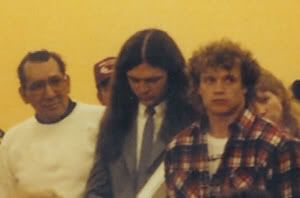Across the Universe
Barack Obama is a talented communicator. Even his opponents admit that. Some of his supporters have compared him to John F. Kennedy and Martin Luther King, Jr. These comparisons have been the source of bitter attacks by the Clinton campaign in the democratic primary, and the same attack tactics will be used by the McCain campaign in the fall. I thought it might be interesting to take a look at what different people mean by the comparisons of a living person to a historic figure.
In the early 1990s, there was a struggle between the traditional Haudenosaunee (Six Nations Iroquois Confederacy) and those interests that promote gambling in the United States. It created tensions on many levels, and involved the Iroquois’ Grand Council of Chiefs, individual nations/tribes Council of Chiefs, Clan Mothers, the State of New York, and the federal government.
I did an interview with an anthropologist who was recognized as an expert in Haudenosaunee - US relations. He had served as an "expert witness" in some of the most important court cases of recent years. At one point in our discussion, I mentioned how a certain Iroquois leader reminded me of a leader from the Revolutionary War era. The anthropologist then provided a fascinating comparison of the roles of more than a dozen of the chiefs and other influential leaders of the Confederacy in the late 1700s and the late 1900s. He understood.
Each of the member nations select individuals to serve on their Council of Chiefs, and who also serve on the Confederacy’s Grand Council of Chiefs. These chiefs maintain their individual identity. And they also serve in a position which is identified by the name/title of the first person who held that seat.
The best-known position name would be "Tadodaho." He is the "chief among chiefs." Many people around the world knew Leon Shenandoah when he served as Tadodaho. When he spoke in Europe, or to the United Nations, or to a group of students, they recognized him as the Tadodaho. But they also knew he was Leon Shenandoah.
The original Tadodaho was a fierce man, with a crooked mind. It is said that he had snakes for hair. This is symbolic, of course. The original Tadodaho was twisted by anger, fear and hatred. He was as evil as Dick Cheney. But he changed.
The change came from meeting with a man called the PeaceMaker, and his co-worker, who today people call Hiawatha. The PeaceMaker had met Hiawatha at a time when Hiawatha grieved from the loses associated with a society in decay. At first, Hiawatha rejected the words of the PeaceMaker. Eventually, he accepted them, and was transformed. Together, they transformed the Tadodaho, by using words to comb the snakes out of his hair.
As Tadodaho, Leon did not serve one Clan or even one nation/tribe. He served the entire Confederacy. In times of dispute – and there were many – he had to listen to everyone. Friend and foe alike. That was part of the responsibility that Leon the individual man accepted when he took the position of Tadodaho of the Haudenosaunee. It is a difficult role for any human being.
There were often people who felt that Leon should take their side in a dispute, and who said he was betraying this group or that group. But most people who met Leon found him to have a type of strength that only a very few people have: the inner strength of a person who is willing to speak to and listen to those who strongly oppose him.
As the "chief of chiefs," Leon used the name Tadodaho. The actual names of the men we call the PeaceMaker and Hiawatha have been "retired," because of their special meaning. I know that many of the people who are troubled by comparisons of Obama to JFK and MLK are not trying to insult Obama: they hold JFK and MLK in a special place. Like Hiawatha, they have wounds from the decay that struck down Martin and John in the 1960s. I understand why many people want to retire those names. It is because of their admiration for JFK and MLK. But I am convinced that JFK and MLK would prefer that we not place them on a stained glass window, and instead channel their energy into today’s society.
The Iroquois are not, of course, the only people who view the world this way. When we look at the bible, we see people comparing John the Baptist to Elijah. And we see people asking Jesus if he is a prophet returned. Tribal people view the experience of life as part of a great cycle, where modern people tend to view time as a straight line. I believe that it is both a cycle and a straight line. And I think that we are at a point in human history when we can approach the intersection of the two in a good way.


0 Comments:
Post a Comment
<< Home